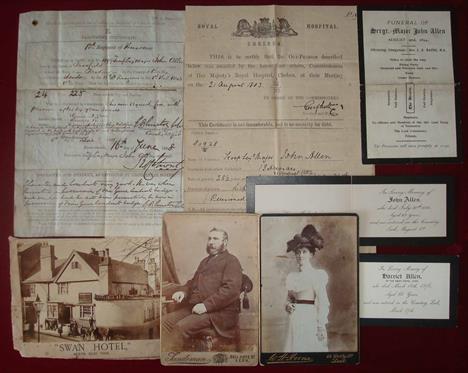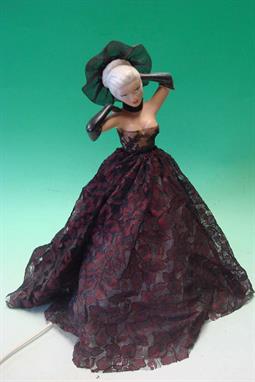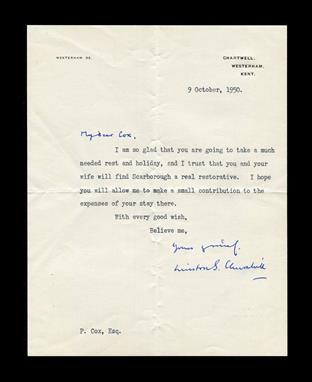534310 Preisdatenbank Los(e) gefunden, die Ihrer Suche entsprechen
534310 Lose gefunden, die zu Ihrer Suche passen. Abonnieren Sie die Preisdatenbank, um sofortigen Zugriff auf alle Dienstleistungen der Preisdatenbank zu haben.
Preisdatenbank abonnieren- Liste
- Galerie
-
534310 Los(e)/Seite
Bing (Germany) large tinplate clockwork Open Tourer: Scarce example is dark green, with black trim and running boards, grey uniformed chauffeur figure, includes headlamp fittings, bright plated hubs with rubber tyres including rear mounted spare, substantial clockwork motor in working order with brake, steerable front wheels, opening tool box to right-hand running board, includes large clock type key, some light play wear but generally a Good Plus finish (some of the rubber tyres have slight flat spots and 1 Head Lamp been loose has bracket has been broken), 12"/31cm long.
Very Important Military Document to a Charge of the Light Brigade Charger: Lot consists of Vellum Army discharge certificate, Chelsea Hospital Pension certificate, Cabinet Photographs of Himself and his Wife, Memoriam Cards for him and his wife, Funeral Programme and a 1896 sepia photograph of the Swan Hotel in Leek where you can see clearly Harriet Allen`s name on the Sign. Comes with some copy paperwork (note: John Allen`s Medals Sold at Auction 31st March 2010 for £18,000) 1199 Corporal John Allen 13th Light Dragoons. Was one of the few who received the Distinguished Conduct Medal for heroism during the disastrous attack. His horse was shot from beneath him as he sped into the "valley of death" at Balaclava during the Crimean War in 1854. Allen was at the front of the attack and took a bullet in the knee in the thick of the carnage after his horse was shot dead beneath him. As he made his way back to British lines he found fellow trooper Joseph Malone trying to rescue a wounded officer. They caught a rider-less horse and put the officer on it and managed to get the casualty back to safety. Malone won the Victoria Cross. Allen signed up as a soldier at 16 and was discharged in 1868 after 24 years` service. He died aged 68. Of the 600-plus men who took part there were 278 casualties - and 335 horses were killed. "Post-military career, he was landlord of the Swan Hotel in Leek, Staffordshire, from 1887 until his death there in July 1894.
Victorian Police Station Blue Lamp: Black Iron work framed lamp having Blue glass inserts with Police etched out to allow the light to shine through comes with original bracket (Note this lamp came from Abington Police Station in Oxfordshire and comes with copy photograph of lamp in place (Glass as been replace at some time) 54 x 36 x 36 cm
A rare POW Rolex Oyster Chronograph, circa 1941, with interesting WW2 history. Stainless steel `monobloc` Oyster case, ref 3525, serial number 186052, indicating a manufacture date of 1940/41. Black dial signed - Rolex Oyster Chronograph Antimagnetic - with gold coloured numerals and outer telemetric and tachometric scales; luminous hour and minute hands; subsidiary dials for running seconds and minutes elapsed. Signed 17 jewel, manual win chronograph movement with overcoil hairspring and monometallic balance. Dial, case and movement signed. Later fitted leather strap. Diameter 35mm excl. crown. Included with this lot will be Flt/Lt Imerson`s Gold fish Card issued in 1943, copies of period photos of him and his wife (some bearing the Stalag L3 `gepruft` stamp), a copy of his amazing story and the expanding bracelet that was fitted to the watch in the 1960s. This watch was ordered by a British RAF bomber pilot, Flight Lieutenant Gerald A. D. Imeson, whilst a Prisoner of War in Stalag Luft III. It was sent to him at the camp via the International Red Cross in Geneva. He was the pilot of Wellington bomber R1219 of 101 Squadron that was shot down and crashed into the North Sea in October 1941. Stalag Luft III was the scene of the ‘Great Escape’ in 1944 where he was involved with tunnel preparations and allocated No. 172 in the escape plan. Early in 1945 he and all the other POWs in the camp were force-marched across Germany in extreme winter conditions on what became known as the ‘Long March’. This watch accompanied him throughout his ordeal as a POW until liberation in May 1945. Condition Report: Overall the watch is in good, original condition. The hand wound movement is currently running with a good action and the chronograph feature functions correctly. The original black dial has good patina with slight fading around the hour numerals, noticeable with an eyeglass. Original hands show very light pitting. The steel case is in good condition with slight bruising and scratches evident (as would be expected). One chronograph pusher has end plating worn away (the other was replaced by Rolex during a service in 1980). Leather strap and buckle are not original to the watch. As with all watches sold, we do not guarantee the accuracy or working of this watch and would recommend it is serviced before use. “Rolex have confirmed that their records show that Chronograph ref 3525, s/n 186052 was produced by them in 1941”.
A Sheaffer ballpoint pen in stainless steel, etched `Toyota Guild`, with sprung lid case, a Sheaffer fountain pen in stainless steel with gold net pattern, with sprung lid case, a Sheaffer No-Nonsense The Card-players Gift Pack (unopened), a Watermans Paris fountain pen in metallic light green, with case, a Japanese ballpoint pen with cloisonné style decoration, with case, a modern embossed `sterling silver` dip pen, with case, and a modern blue plastic dip pen with six interchangeable nibs.
An early 20th Century French gilt metal and marble clock garniture, the clock with eight day movement striking on a bell, the circular enamel dial with Arabic numerals, the square case surmounted with an urn above scroll decoration, rectangular stepped base and scroll legs, height approx 41cm, together with a pair of matching four scroll branch five light candelabra, with pendulum and key.
An album containing approximately 224 postcards of military interest, including photographic postcards titled `6th O.S. RMLI Battery`, `R.M.L.E. School of Navigation Portsmouth Dec 1921`, `Royal Marine Light Infantry, Walmer Castle, Kent, Engineering Party`, `Royal Marine Church Parade`, `Men`s Barrack Room, R.M.A., Eastney Barracks`, `Royal Marine Barracks, Walmer`, `Band 1st Battalion Hampshire Regiment` and `Pipers Black Watch`, also including approximately 81 modern postcards.
THE PERCY COX ARCHIVE. - THE CHURCHILL FAMILY. Sir Winston Leonard Spencer CHURCHILL (1874-1965), Clementine Ogilvy Spencer CHURCHILL, Baroness SPENCER-CHURCHILL (1885-1977), Mary SOAMES, Baroness SOAMES, and others. A small archive of photographs, telegrams, autograph letters, signed letters, notes and cards, most relating to the Churchill family`s relationship with Percy Cox, O.B.E., circa 1945-1974. Provenance: Percy Walter Cox and thence by descent. Note: Percy Cox (1888-1975), was the Estates Manager at the Churchills` home, Chartwell, in Kent in the late 1940s and the 1950s. This interesting archive throws some light on Mr Cox`s work for Sir Winston Churchill and the personal esteem in which he and his wife were held by Winston, his wife, Clementine, and their youngest daughter, Mary. Further details on the contents of this archive are available on request.
RAILWAYS. A plan and application for a `Surrey & Sussex Light Railway`, circa 1902, in three printed documents titled `Plans and Sections`, `Arrangements of Sections` and `Book of Reference`, together with a small collection of related ephemera (all rolled). Note: the railway was never undertaken.
India - Gandhi and Jewish holocaust Nazis publication 1939. Extremely rare publication on Mahatma Gandhi and the Holocaust. Two letters to Gandhi from Martin Buber and J. L. Magnes by the group The Bond Rubin Mass^ Jerusalem^ April 1939. First edition. Light blue stapled wrappers^ 44 pages. Contents include - 1. A letter to Gandhi from Martin Buber; 2. A letter to Gandhi from J L Magnes; 3. Gandhi’s statement. The letters are a response by two leading Jewish adherents of non-violence to Ghanhi’s advise to the Jews of Germany to adopt the tactics of Satyagraha (Passive Resistance) in the face of the Nazi persecution of Jews in Germany. In view of the Nazi persecution of the Jews in Germany^ Gandhi offered satyagraha as a method of combating oppression and genocide^ stating: “If I were a Jew and were born in Germany and earned my livelihood there^ I would claim Germany as my home even as the tallest Gentile German might^ and challenge him to shoot me or cast me in the dungeon; I would refuse to be expelled or to submit to discriminating treatment. And for doing this I should not wait for the fellow Jews to join me in civil resistance^ but would have confidence that in the end the rest were bound to follow my example. If one Jew or all the Jews were to accept the prescription here offered^ he or they cannot be worse off than now. And suffering voluntarily undergone will bring them an inner strength and joy” The publication stated `This conversation is the first between the Jews and Gandhi is the first between Israel and India. This is a significant moment in our eyes` Very scarce copy of this publication published in 1939.
India – Sikh Punjab Ranjit Singh Emily Eden up the country. A fascinating account into the Sikh court by Emily Eden “Up the Country” by Emily Eden. Hardback reprint published in 1978 by Curzon Press – first published in 1866. Letters written to her sister from The Upper Provinces of India with an introduction by Edward Thompson. 410 pages. Jacket taped to extremities with light grubbiness. Emily Eden got on well with Maharaja Ranjit Singh in 1838 and along with sketching him wrote in her book: "Another of Runjeet`s topics was his constant praise of drinking^ and he said he understood that there were books which contained objections to drunkenness^ and he thought it better that there should be no books at all^ than that they should Contain such foolish notions. He is a very drunken old profligate^ neither more nor less. Still he has made himself a great king; he has conquered a great many powerful enemies; he is remarkably just in his government; he has disciplined a large army; he hardly ever takes away life^ which is wonderful in a despot; and he is excessively beloved by his people. One of the most in depth account of the court of Lahore and Ranjit Singh
India Punjab – Coloured Lithograph book on the Sikh Wars. Fine 1849 1st ed of Mooltan^ during and after the Siege. Being Twenty-one Drawings^ from Sketches taken on the Spot by John Dunlop^ M.D. Assistant Surgeon H.M.`s 32nd Regiment. And lithographed in Tints^ by Andrew Maclure. With a descriptive and historical account of the Siege of Moolta. Uncommon plate book recording the five month siege of Mooltan^ now Multan in Pakistan. The attempt of the British to impose a new ruler on the city led to the defiance of Dewan Mulraj^ and to the siege which precipitated the Second Sikh War. The plates include images of the city itself^ the participants including “Moolraj” and his brothers^ and key moments during the siege^ the text offers a reasonably full description of events^ partly drawn from Dunlop’s own account. Folio (370 x 265 mm). Original red cloth lettered in gilt on the upper board and with panels in blind and gilt^ light cream endpapers. Hand-finished tinted lithographic pictorial half-title and 21 similar plates^ original tissue-guards intact. A little rubbed and soiled^ light browning and foxing internally^ some light marginal foxing^ very good.
THE EMPIRE EARLY 20TH CENTURY TYPEWRITER cast metal and black enamel body with fan shaped plate covering action, aluminium space bar 8 1/2" (21.5cm) carriage on oblong mahogany base, together with a YOST `LIGHT RUNNING TYPEWRITER NO. A with cast metal and black conventional body and keyboard, 9 3/4" (24.8cm) carriage (2)
COLLECTION OF CAMERA ACCESSORIES MAINLY LENSES, including Nikon af f4-5-6, 70-300mm (x2), Tamron f3.8, 75-250 mm, cased, auto teleplus 2 x converter, Canon EF, f3.5-4.5, 35-105mm Hanimex automatic MC, f2.8, 135mm Dall Meyer max-lite, 3 1/2" Nikon af f1.8, 50mm, Helios Macro bellows attachment for Olympus OM, boxed, two light meters, filters etc, contents of one box
VICTORIAN MAHOGANY AND BRASS BIUNIAL MAGIC LANTERN, the two projector lenses with rack and pinion focussing the tall body fitted to receive two light sources/lamps (absent) with side opening vented doors, original black metal chimney on mahogany base with moulded edge, 25 1/2" (64.8cm) high overall
GOOD W. WATSON & SONS, LONDON, LATE 19th CENTURY MAHOGANY AND LACQUERED BRASS MAGIC LANTERN, the front brass plate inscribed W. Watson & Sons, 313 High Holborn, London, No 1379, having 8" lens with rack and pinion focussing and fitted with mahogany sliding plate holder, the body hinged to allow adjustment of inclination, having side and rear opening door to access the now electrified light source, blued metal chimney, 18 3/4" (47.6cm) long lens closed down
19th CENTURY LACQUERED BRASS SLIDE PROJECTOR/MAGIC LANTERN WITH HORIZONTALLY MOUNTED CYLINDRICAL BODY on cast iron and brass stand with pivoting mount, having simple rack and pinion focussing, the body widening to the rear and possibly later adapted to take screw in electric light source, 16 1/2" (42cm) long lens closed down 13" (33cm) high
THE CITY SALE AND EXCHANGE, LONDON - SALEX LITTLE JUNIOR PHOTOGRAPHIC ENALRGER, oak and black japanned metal body, the light source sliding on the base and connected with bellows to lens body, the front with folding bellows and rack and pinion focussing (lacks objective lens and spirit lamp)
19th CENTURY BLUED METAL AND BRASS MAGIC LANTERN, the brass main tube with simple slide in and out adjustment, the objective lens with rack and pinion focussing, the body with brass plate, Patent No 245 and having spirit fired light source with four adjustable burners, extending square chimney, 16 1/4" (41.3cm) long with lens closed down, together with VERY SIMILAR BUT SMALLER MAGIC LANTERN, (incomplete) (2)
NINETEENTH CENTURY LACQUERED BRASS AND MAHOGANY MAGIC LANTERN, having original lime-light gas powered illumination including a box of `Mabor Indestructible` Lines` the mahogany body with side opening ventilated panel doors, brass objective lens with rack and pinion focusing, the rear aperture with black plush cloth curtain on rail, 24" wide approx, TOGETHER WITH A NINETEENTH CENTURY LACQUERED BRASS 7" ENLARGING OBJECTIVE with rack and pinion focusing and a VERY LARGE SELECTION OF GLASS LANTERN SLIDES, housed in THREE MAHOGANY SIX DRAWER CABINETS, many of the slides in sets to include comic `Adventures of a cyclist` 12 slides showing cyclists on penny farthings, Old Mother Hubbard, `Polar Expedition` 12 colour slides etc. as per vendors inventory showing in excess of 860 slides
EARLY TWENTIETH CENTURY `OPTISCOPE` NO. 8 BY HOUGHTON AND BUTCHER, LONDON having chromium plates and black metal body brass screw in Houghton and Butcher projection lens 10" focus on cruciform stand and the black metal storage box, TOGETHER WITH AN ELECTRIC HAND HELD LIGHT PROJECTOR, in the shape of a hair dryer (2)
-
534310 Los(e)/Seite

























































